All Concerning Psychotomimetic Substances: Their Duty in Psychological Research
Psychotomimetic substances, such as LSD and psilocybin, have garnered raising passion in emotional research for their ability to replicate psychotic signs and provide insight into numerous mental health problems. Their communications within the mind, especially with serotonin and dopamine pathways, suggest a facility partnership between awareness and neurobiology that might open unique restorative opportunities. As researchers proceed to investigate their prospective applications, ethical factors to consider surrounding their use in medical settings come to be paramount, elevating important concerns concerning security and informed authorization that call for additional expedition.
Meaning of Psychotomimetic Compounds
In the world of mental research, psychotomimetic substances are materials that can induce impacts looking like those of psychosis, such as hallucinations, misconceptions, and transformed assumptions of reality - About Golden Psycho. These substances can be classified into numerous groups, consisting of hallucinogens, dissociatives, and specific energizers, each generating distinctive emotional effects
The medicinal activity of psychotomimetic compounds often includes inflection of neurotransmitter systems, particularly those pertaining to serotonin, dopamine, and glutamate. Compounds like lysergic acid diethylamide (LSD) mainly act on serotonin receptors, leading to extensive alterations in sensory understanding and cognition.
The energy of psychotomimetics in research hinges on their ability to mimic psychotic signs and symptoms, supplying a model for recognizing the hidden devices of psychotic conditions such as schizophrenia. By studying the effects of these substances, researchers can acquire understandings right into the neurobiological and mental processes that add to psychosis.
Moreover, psychotomimetic compounds have been checked out for their healing possibility in dealing with various mental wellness problems, including depression and anxiousness, highlighting their double duty in both research study and prospective professional applications.
Historical Advancement and Context
The expedition of psychotomimetic substances has a rich historical context that goes back to ancient worlds, where materials such as psilocybin mushrooms and peyote were used in spiritual and recovery practices. These early uses usually intertwined with spiritual rituals, recommending an extensive reverence for the altered states of awareness generated by these compounds.
The mid-20th century noted a considerable pivotal moment in the study of psychotomimetic compounds, specifically with the synthesis of LSD by Albert Hofmann in 1938. The subsequent popularization of LSD in the 1960s catalyzed a wave of passion in both its mental effects and potential healing applications. Researchers started to explore exactly how these materials might mimic psychotic states, giving understandings right into mental disorder.
However, the increasing organization of psychotomimetics with counterculture activities brought about governing backlash, culminating in the criminalization of a lot of these compounds. In spite of these obstacles, the resurgence of rate of interest in the therapeutic capacity of psychedelics in the 21st century has motivated restored study. This historical trajectory emphasizes the advancing perception of psychotomimetic compounds, changing from sacred substances to topics of scientific inquiry and, possibly, restorative promise.
Systems of Action
Recognizing the devices of action of psychotomimetic over here substances reveals the detailed means these materials connect with the mind's neurochemistry. These substances primarily apply their impacts through inflection of neurotransmitter systems, especially serotonin, dopamine, and glutamate.
Along with serotonin, dopaminergic paths are significantly affected by compounds like mescaline and specific cannabinoids, which can lead to modified states of consciousness and changes in mood and motivation. In addition, the NMDA receptor antagonism observed with substances like ketamine highlights an additional pathway with which psychotomimetics might induce dissociative states and profound alterations in believed processes.
The neurochemical cascades launched by these interactions cause complex and multifaceted psychological effects. Comprehending these mechanisms is essential for both the advancement of mental research study and the therapeutic capacity of psychotomimetic substances, as they offer understandings into the underlying neural correlates of modified states of awareness.
Current Study and Applications
Current examinations into psychotomimetic compounds have revealed a renewal of passion in their therapeutic applications, specifically in the areas of psychiatry and psychology. Scientists have started exploring compounds such as psilocybin, LSD, and ayahuasca for their potential to reduce signs and symptoms associated with different mental wellness problems, including anxiety, anxiety, and PTSD.
Clinical tests have actually demonstrated that, when administered in controlled environments, these substances can promote extensive mental experiences, advertising psychological advancements and boosted restorative end results. Studies have actually shown that psilocybin-assisted therapy can lead to substantial reductions in treatment-resistant depression, with results lasting for several months post-treatment.
Furthermore, psychotomimetic substances are being evaluated for their capability to browse around these guys promote neuroplasticity, possibly enabling more reliable rewiring of maladaptive thought patterns. These searchings for suggest that such compounds might act as adjuncts to conventional psychotherapeutic methods, boosting the efficacy of therapeutic treatments.
As study advances, the emphasis is changing towards recognizing the optimum dosages, healing settings, and participant features that can make the most of the advantages of these compounds. This burgeoning field holds guarantee for transforming psychological wellness therapy paradigms and resolving the restrictions of standard psychological medications.
Honest Considerations in Research

Navigating the moral landscape of research entailing psychotomimetic compounds is important to making certain individual safety and the integrity of research study end results. Researchers must prioritize educated consent, guaranteeing that participants fully understand the possible risks and benefits linked with the substances being examined. This consists of providing comprehensive details concerning feasible emotional effects, consisting of severe and lasting influences, and enabling participants the chance to withdraw from the research any time scot-free.
In addition, moral oversight by institutional testimonial boards (IRBs) is crucial. IRBs assess research methods to secure participant well-being and promote ethical requirements. This examination helps mitigate threats and makes certain that research studies are carried out with scientific rigor. Additionally, the capacity for browbeating must be thoroughly assessed, specifically when prone populations are included.
Privacy is one more paramount factor to consider. Scientists need to execute durable measures to safeguard individuals' identities and data, especially provided the delicate nature of experiences related to psychotomimetic substances (About Golden Psycho). Inevitably, a dedication to moral techniques not just cultivates trust fund between researchers and participants but likewise improves the integrity and credibility of the research study end results, adding to the advancement of mental knowledge

Verdict
To conclude, psychotomimetic compounds, especially classic psychedelics such as LSD and psilocybin, deal substantial understandings into psychological problems through their distinct systems of action. Their therapeutic capacity in dealing with problems like stress and anxiety and PTSD highlights the relevance of ongoing other study in this field. Nonetheless, guaranteeing moral criteria in research study techniques is vital for individual safety and security and informed permission, allowing for a liable expedition of these substances' advantages and implications within emotional science.